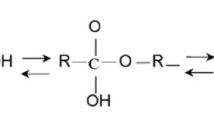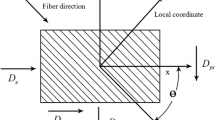Abstract
Hygric behavior of woven glass/epoxy composites is investigated by characterizing them using a novel experimental technique calledhunch-up technique. Based on one-dimensional diffusion theory, the through-thickness distribution of moisture concentration is derived and experimentally predicted for a laminate exposed to water. A procedure is prescribed to determine average axial hygric strain from the measured hunch-up distance of an axially constrained specimen exposed to water. The experimental results show that the hunch-up distance is extremely sensitive to moisture expansion. There results also give excellent confirmation to the theoretical predictions. An error analysis reveals that the hunch-up technique can reduce errors by an order of magnitude better than traditional measurement techniques.
Similar content being viewed by others
References
Shen, C.W. andSpringer, G.S., “Moisture Absorption and Desorption of Composite Materials,”Journal of Composite Materials,10,2–20 (1976).
Gazit, S. and Ishai, O., “Hygroelastic Behavior of Glass-reinforced Plastics Exposed to Different Relative Humidity Levels,” Proceedings of the Conference on Environmental Degradation of Engineering Materials, Virginia Polytechnic Inst., Blacksburg, VA, Oct. 1977, 383–392.
Hahn, H.T. andKim, R. Y., “Swelling of Composite Laminates,”Environmental Effects on Composite Materials, ASTM STP 658, ed. J.R. Vinson, American Society for Testing and Materials, Philadelphia, 98–120 (1978).
Whitney, J.M., Daniel, I.M. andByron Pipes, R., Experimental Mechanics of Fiber Reinforced Composite Materials, Monography No. 4, Society for Experimental Mechanics, Bethel, CT, Prentice Hall, Englewood Cliffs, NJ, Rev. Ed. (1985).
Yaniv, G., Peimanidis, G., andDaniel, I.M., “Method for Hygrothermal Characterization of Graphite/Epoxy Composite,”Journal of Composites Technology and Research,9,21–25 (1987).
Strain Gauges User Guide, Brochure I 24.38.1e, Hottinger Baldwin Messtechnik GMBH, Postfach 10051, D-64201, Darmstadt.
Wang, T.M. andDaniel, I.M., “Thermoviscoelastic Analysis of Residual Stresses and Warpage in Composite Laminates,”Journal of Composite Materials,26 (6),883–899 (1992).
Tsai, C.-L. andDaniel, I.M., “Method for Thermo-mechanical Characterization of Single Fibers,”Composites Science and Technology,50,7–12 (1994).
Daniel, I.M. andIshai, O., Engineering Mechanics of Composite Materials, Oxford University Press, New York (1994).
Author information
Authors and Affiliations
Rights and permissions
About this article
Cite this article
Tsai, CL., Wooh, SC. Hygric characterization of woven glass/epoxy composites. Experimental Mechanics 41, 70–76 (2001). https://doi.org/10.1007/BF02323107
Received:
Revised:
Issue Date:
DOI: https://doi.org/10.1007/BF02323107




